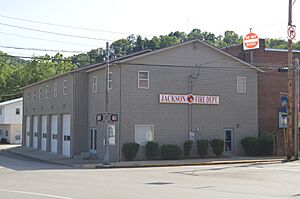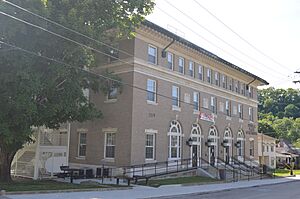National Register of Historic Places listings in Breathitt County, Kentucky facts for kids
Hey there, young explorers! Did you know that some buildings and places are so special they get listed on a national register? This article is all about the cool historic spots in Breathitt County, Kentucky, that are part of the National Register of Historic Places.
It's like a special club for old buildings and areas that have important stories to tell. There are 7 amazing places in Breathitt County that are currently on this list. One other place was once listed but isn't anymore. Let's dive in and learn about them!
Contents
Discover Historic Places in Breathitt County!
What is the National Register of Historic Places?
The National Register of Historic Places is the official list of the nation's historic places worth saving. It's like a hall of fame for buildings, structures, objects, sites, and districts that are important in American history, architecture, archaeology, engineering, or culture. When a place is on this list, it means it's recognized for its special past.
Explore Historic Buildings in Jackson
Most of the historic places in Breathitt County are located in the town of Jackson. These buildings tell us a lot about what life was like in the past.
The Old Breathitt County Jail
This old jail building is located at 1027 College Street in Jackson. It was added to the National Register of Historic Places on February 21, 1986. Even though it was a jail, it's recognized for its historical importance and how it shows the architecture of its time.
Crain's Store: A Blast from the Past
The Crain's Wholesale and Retail Store building stands at the corner of College and Broadway Streets in Jackson. It joined the historic list on the same day as the jail, February 21, 1986. This building was once a busy store, showing how people shopped and traded goods many years ago. Today, it houses the Jackson Fire Department.
Jackson's Historic Downtown Area
The entire Jackson Commercial District is a historic area! It covers Main Street between Court Street and Broadway Street. This district was also added to the National Register on February 21, 1986. It's special because it includes many buildings that together show what the main business area of Jackson looked like in the past. Imagine all the shops and people who walked these streets!
The Jackson Post Office Building
You can find the Jackson Post Office at the junction of Hawk and Broadway. This building became a historic site on July 23, 1990. Post offices are often important community buildings, and this one has served the people of Jackson for a long time.
Jackson Methodist Church
The M.E. Church, South, now known as Jackson Methodist Church, is located at 1022 College Street. It was added to the National Register on February 21, 1986. Churches are often central to a community's history, serving as places of worship and gathering for many generations.
The Stacey Hotel: A Historic Stay
The Stacey Hotel was once a prominent building at the corner of Broadway and College Streets. It was listed on February 21, 1986. Hotels were very important in the past, providing places for travelers to rest and meet. While the building itself may have changed, its historical significance is still recognized.
Morris Fork Presbyterian Church: A Community Hub
The Morris Fork Presbyterian Church and Community Center is located at 908 Morris Fork Road in Morris Fork. This site was added to the National Register more recently, on November 15, 2010. It's recognized not just as a church, but also as a community center, showing its role in bringing people together in the Morris Fork area.
Places That Were Once Historic
Sometimes, a place that was once on the National Register of Historic Places might be removed. This can happen for different reasons, like if the building is changed too much or if it's no longer standing.
The Old L & N Railroad Depot
The Louisville and Nashville Depot in Jackson was once a listed historic site. It was located on Armory Drive and was added to the Register on February 21, 1986. However, it was removed from the list on February 6, 1990. Railroad depots were very important in the past for travel and moving goods, connecting towns and cities.








